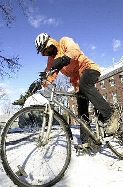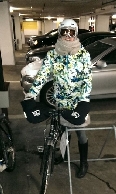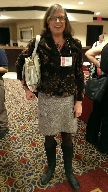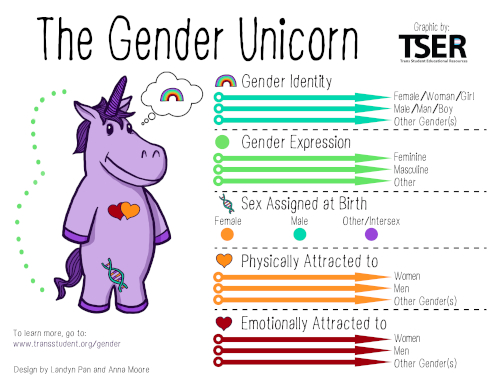
Doug Mink, February 2004 | Changes:I have not always had the same name and appearance.Here's why: |


Jessica Mink outside and inside, March 2014 |
|
I have been a transgender person for as long as I can remember.
Despite having been designated male at birth and living as a male person
most of the time for my first 60 years, I have, for as long as I can
remember, identified as much or more as a woman rather than as a man.
Being attracted to women romantically and physically made it easy to
live as a male through two marriages and a few medium-term
relationships in between.
After struggling with this bigender disparity for much of my life, it became increasingly clear to me during the first decade of the twenty-first century that my base gender identity was definitely female and that I would be a happier person if I could live as one. Fortunately, along the way I discovered that I could split the difference on my other dual identities of scientist vs. programmer and open-space activist vs. bicycle activist. I spent a few years learning and thinking about possible futures, and in 2008, I started spending a lot of time out in the world as woman, including on trips across and out of the country. In the late spring of 2011 when full transition and divorce were on the horizon, I started transitioning to my friends in Boston's bicycle community and telling my colleagues at work. In the middle of that summer, the day after our first meeting with divorce lawyers, I crashed my bike and was hospitalized for a few days, causing some awkward but educational moments as my appearance and identification did not match. As soon as I was allowed back on my bike, I told the rest of my family and started leading rides as Jessica, including a 60-mile ride for my 60th birthday. By the end of 2011, I was separated and living full-time as myself, including at work. I have been fortunate to have an accepting circle of friends in my neighborhood, the bicycle, open space, and religious communities of metropolitan Boston, the astronomical community both where I work and world-wide, and a supportive family. As the Covid-19 ends in my part of the world in the summer of 2021, my world in general considers me to be a woman, and that's how I identify and live, though my friends know that I haven't always been one and that I still have a lot to learn. My Bicycle WorldIn February 2012, I came out in front of 500 people by getting the first Boston Bikes Lifetime Advocacy Award. My bike interests are covered by this cute cartoon interview with Pug-Velo in 2013 and this video interview by Melanie Morris in July 2015 for Bay State Biking News at Somerville Community Access TVIn December 2017, I was interviewed for an article in the Boston Globe. I volunteered to be photographed, hoping to present an example of biking stylishly in cold weather to other female bicyclists, and it turned out pretty well in Here's how to gear up for cold-weather biking. I put all of my answers to the reporter's questions on my blog as Biking Through the Winter. My Astronomical UniverseI am an intersectional member of the American Astronomical Society AAS Committee on the Status of Women in Astronomy (CSWA) and Committee for Sexual orientation and Gender identity Minorities in Astronomy (SGMA, formerly WGLE) and involved in the organization's Diversity Forum. I was also on the Organizing Committee for the 2015 Inclusive Astronomy Conference. and worked on the Nashville Recommendations, which are on the AAS web site. Here's a presentation about all of this which I gave at Out to Innovate 2017.In April 2014, I told the story of my transition in astronomy to Wladimir Lyra and Stefano Meschiari of what was then the Working Group on LGBTIQ Equality (WGLE, now SGMA) of the American Astronomical Society. I have posted to the Women in Astronomy blog, where I have laid out my thoughts on gender and its impacts on my professional life:
These posts in that blog discuss policy issues that affect trans people:
And these posts in the same blog discuss some other professional issues which have affected me:
Reaching out to other sciences in January 2018, I spoke on "Becoming Diverse" at the 2018 American Meteorological Society Annual Meeting Coriolis Reception and participated on a panel with three other women on "the importance of inclusion and diversity in atmospheric and computational science and related fields" at the Society's Women in Atmospheric Sciences Luncheon. My next talk was at TERC in Cambridge in July, 2018 on "Privilege, Status, and Pipelines in STEM" On June 7, 2021, I presented at talk at the June AAS Meeting SGMA reception on Post-Publication Name Changes and what various publishers of scientific journals are doing about it. A nice summary of the issue, including some of my comments is in Macy Huston's June 11, 2021 Astrobites, Retroactive Name Changes in Astronomical Publications. Sermons and NarrativesIn 2015, I started speaking more in public about my life. I've given short sermons at Unitarian-Universalist churches on "Finding My Place in the Universe" in West Roxbury and "Finding My Voice" in Plymouth, Massachusetts.In January 2017, I told my story after the first performance of "Tran Scripts, Part 1: The Women", a play by Paul Lucas at the American Repertory Theater. The theater put out this useful booklet for use in explaining transgender in classrooms. General InformationIn early 2015, my friend Dorie Clark wrote a couple of useful articles (I'm in both) for the Harvard Business Review:
In August 2015, the American Psychological Association announced new Guidelines for Working With Transgender and Gender Nonconforming People. If you wish to learn more, a good online resource for understanding transgender issues is Understanding Transgender at the web site of the National Center for Transgender Equality.
"Assigned Male", by Sophie LaBelle, is a great web comic about a young trans* woman who really knows who she is, no matter what the adults around her might think. Here and here are some pretty good answers to questions you might have about transgender people. Being able to finally be myself in the world is freeing me from constraints which have held me back--though some of my long-time friends may disagree--from committing more of myself to my friends, my work, and my causes. If you have any questions, feel free to email me. Now that you know, especially if you first met me as Jessica, please be careful about telling other people. Since I transitioned, I really, really do not like being referred to with male pronouns, especially by people I am just meeting. I'm public to those who know me, but prefer to just be a woman in the world. Here is a good list of reasons to not talk about it from a friend of mine. As a person who has tended to be more into books than real people, I've read about more than acted upon my transgender feelings over many years. Here are some books in my library which might help others understand my position. -Jessica Mink (2021-06-25) |

